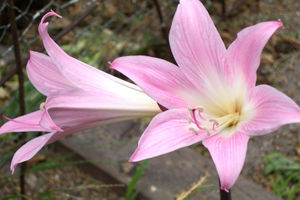Amaryllis (genus)
| amaryllis | ||||||||||||
|---|---|---|---|---|---|---|---|---|---|---|---|---|

Belladonna Lily ( Amaryllis belladonna ) |
||||||||||||
| Systematics | ||||||||||||
|
||||||||||||
| Scientific name | ||||||||||||
| amaryllis | ||||||||||||
| L. |
Amaryllis is a plant kind from the family of the Amaryllis (Amaryllidaceae). The only two species are common in winter rain areas of southern Africa . The "Amaryllis" sold in the garden trade, especially during Advent and Christmas, is of the genus Hippeastrum ( knight stars )according to today's botanical system.
description

Appearance and leaves
The amaryllis is a perennial herbaceous plant . These geophytes form an onion as a persistence organ. The plants are leafless in the dry season and only form new leaves after the flowering period. The basal, alternate and two-line arranged five to eleven leaves are simple, narrow to wide belt-shaped, parallel-veined and entire.
Inflorescences and flowers
The upright, strong, leafless inflorescence stem is not hollow as in Hippeastrum . In a doldigen inflorescence are two to twelve flowers that two bracts are surrounded (bracts). The stalked flowers each stand over a thread-like bract (bracteole).
The flowers are hermaphroditic, mostly slightly zygomorphic and threefold. In the two circles, the three free bracts are more or less of the same shape. There are two circles, each with three identical, fertile stamens . The stamens can be connected at their base. The dust bags open with a longitudinal slit. Three carpels are fused to form a subordinate, three- chamber ovary. There are four to eight anatropic ovules in each ovary chamber . The stylus ends in a three-lobed scar.
Fruits and seeds
A capsule fruit is formed. The fleshy seeds are more or less spherical with a diameter of about 15 mm.
Chromosomes
The basic chromosome number is x = 11.
Systematics and distribution
The genus Amaryllis was originally defined by Carl von Linné much broader than it is today. Early 20th century, there was a split of this genus, the scientific name Amaryllis to out of kapnahen mountain region of South Africa originating Amaryllis belladonna ( Amaryllis belladonna was limited). Colloquially and also in the plant trade, other species of the earlier large genus are still referred to as " Amaryllis ", especially the knight star species ( Hippeastrum ) from South America . The generic name Amaryllis ( Greek Ἀμαρυλλίς ) is derived from the name of a shepherdess from the Eclogae (10 shepherd poems ) Virgil .
Subsequent to the split, the genus was considered monotypical for a long time , with Amaryllis belladonna as the only species. Only in 1998 was the South African botanist Deirdré Anne Snijman in A Record of Contributions from the National Herbarium, Union of South Africa. A second species is described in Bothalia , Volume 28, Issue 2, p. 193, Amaryllis paradisicola .
There are two species in the genus Amaryllis today. Both species are native to the winter rain areas of southern Africa :
- Belladonna lily ( Amaryllis belladonna L. ): It is common in the Western Cape province of South Africa.
- Amaryllis paradisicola Snijman : It thrives in the extremely arid Richtersveld .
Eponyms
The asteroid (1085) Amaryllis is named after the amaryllis plant genus.
photos
Belladonna Lily ( Amaryllis belladonna ):
swell
- J. Gathe, Leslie Watson: Amaryllis in the Western Australian Flora , 2008. (Section Description)
- John Charles Manning , Peter Goldblatt , Deirdré Anne Snijman: The color encyclopedia of Cape bulbs. Timber Press, USA, 2002. Amaryllis on pp. 62–63 (sections description, distribution and systematics)


